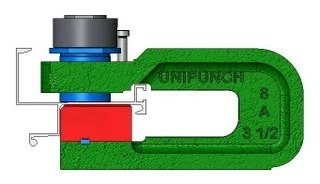Aluminum alloy material is forced into a die with a specific cross-sectional shape using the extrusion method. A powerful ram pushes the metal through the die and out of the die aperturel shape using the extrusion method. A powerful ram pushes the metal through the die and out of the die aperture. When this occurs, it emerges in the precise shape of the die and is carried away along a runout table.
In order to help you better prepare for the financial impact these goods will have on your budget, we\'ve covered some of the major elements that affect the cost markup for bespoke extrusions in this post.
Die Cost
New dies must be created specifically for bespoke profiles from scratch. This results in an increase in the total cost of your order for the manufacturers, who must recover the cost of these specialized dies.
Complex geometries for the new die design will require more time and labor to build, further driving up production costs and lead times for the finished product. This further compounds the problem.
Cost of Aluminum
As you may anticipate, the cost of the base material utilized to make your products will directly affect how much the order will ultimately cost. Numerous elements, including the demand for aluminum globally, market trends, and others, have an impact on its price.
When you have continuous manufacturing requirements with a manufacturer, it might sometimes make sense to buy a sizable quantity of metal all at once to lock in a rate because the price of aluminum has fluctuated significantly in recent years.
In these situations, the extruder purchases a sizable quantity of the metal in advance and uses it over time for your production needs. You can make the extrusion expenses more predictable for you by doing this.
Additionally, it\'s crucial to keep in mind that the costs of various aluminum grades may vary and that a manufacturer is unlikely to have an abundance of the uncommon aluminum alloys that are occasionally requested in custom orders. This may increase the cost of obtaining unique stock.
Profile Dimensions
Extrusion press sizes will vary between extrusion mills. The bulk of extrusions are manufactured on presses that can extrude profiles with widths ranging from 5 mm to 250 mm wide or with weights per meter ranging from 0.1 kg to 120 kg. Due to economies of scale and possibly slower production rates, profiles that are larger or smaller than these dimensions may cost more.
Design
By including design elements like screw ports, snap-fit or interlocking joints, non-slip or grooved surfaces, and hinges in your profiles, you may be able to cut the cost or perhaps completely eliminate the requirement for additional machining.
Cost of Labor
When estimating the price of bespoke aluminum extrusions, labor costs are frequently one of the simplest to forecast. This information is often easy to access and depends on local laws and conditions. Shipping costs may rise when manufacturing overseas, although these are usually offset by higher production volumes.
Additionally, operating costs, equipment acquisitions, maintenance, utilities, and other production costs that may have an impact on overall costs The conditions in the area where the manufacturing takes place have an effect on them as well, albeit they can be a little difficult to measure.
Conclusion
Already, the manufacturing sector is expensive. However, many manufacturers cut costs by paying attention to a few details. By keeping a few things in mind, aluminum extrusion costs can be easily reduced costs by paying attention to a few details. By keeping a few things in mind, aluminum extrusion costs can be easily reduced. Here are all the factors that affect how much aluminum extrusion costs: As a manufacturer, you must consider every area in which you can cut costs.



